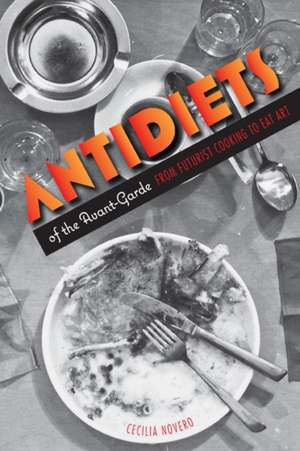Antidiets of the Avant-Garde: From Futurist Cooking to Eat Art
Autor Cecilia Noveroen Limba Engleză Paperback – 29 mar 2010
Discussing
an
aspect
of
the
European
avant-garde
that
has
often
been
neglected-its
relationship
to
the
embodied
experience
of
food,
its
sensation,
and
its
consumption-Cecilia
Novero
exposes
the
surprisingly
key
roles
that
food
plays
in
the
theoretical
foundations
and
material
aesthetics
of
a
broad
stratum
of
works
ranging
from
theItalian
Futurist
Cookbookto
the
magazineDada,
Walter
Benjamin's
writings
on
eating
and
cooking,
Daniel
Spoerri'sEat
Art,
and
the
French
New
Realists.
Starting from the premise that avant-garde art involves the questioning of bourgeois aesthetics, Novero demonstrates that avant-garde artists, writers, and performers have produced an oppositional aesthetics of indigestible art. Through the rhetoric of incorporation and consumption and the use of material ingredients in their work, she shows, avant-garde artists active in the 1920s and 1930s as well as the neo-avant-garde movements engaged critically with consumer culture, memory, and history.
Attention to food in avant-garde aesthetics, Novero asserts, reveals how these works are rooted in a complex temporality that associates memory and consumption with dynamics of change.
Starting from the premise that avant-garde art involves the questioning of bourgeois aesthetics, Novero demonstrates that avant-garde artists, writers, and performers have produced an oppositional aesthetics of indigestible art. Through the rhetoric of incorporation and consumption and the use of material ingredients in their work, she shows, avant-garde artists active in the 1920s and 1930s as well as the neo-avant-garde movements engaged critically with consumer culture, memory, and history.
Attention to food in avant-garde aesthetics, Novero asserts, reveals how these works are rooted in a complex temporality that associates memory and consumption with dynamics of change.
Preț: 223.11 lei
Nou
Puncte Express: 335
Preț estimativ în valută:
42.71€ • 46.40$ • 35.90£
42.71€ • 46.40$ • 35.90£
Carte tipărită la comandă
Livrare economică 21 aprilie-05 mai
Preluare comenzi: 021 569.72.76
Specificații
ISBN-13: 9780816646012
ISBN-10: 0816646015
Pagini: 368
Ilustrații: 38
Dimensiuni: 140 x 216 x 23 mm
Greutate: 0.48 kg
Ediția:1
Editura: University of Minnesota Press
Colecția Univ Of Minnesota Press
ISBN-10: 0816646015
Pagini: 368
Ilustrații: 38
Dimensiuni: 140 x 216 x 23 mm
Greutate: 0.48 kg
Ediția:1
Editura: University of Minnesota Press
Colecția Univ Of Minnesota Press
Notă biografică
Cecilia Novero is lecturer of German and European studies at the University of Otago in New Zealand.
Cuprins
Introduction: Encounters of the Culinary and the Avant-Garde
1. Futurist Banquets
2. Anti-Meals of Anti-Art: Dada-Diets
3. Walter Benjamin's Gastro-Constellations
4. Daniel Spoerri's Gastronoptikum
5. The Neo-Avant-Garde's Convivia
Conclusion. In/Edible Art: What remains?
Acknowledgments
Notes
Index
1. Futurist Banquets
2. Anti-Meals of Anti-Art: Dada-Diets
3. Walter Benjamin's Gastro-Constellations
4. Daniel Spoerri's Gastronoptikum
5. The Neo-Avant-Garde's Convivia
Conclusion. In/Edible Art: What remains?
Acknowledgments
Notes
Index
Descriere
Discussing an aspect of the European avant-garde that has often been neglected-its relationship to the embodied experience of food, its sensation, and its consumption-Cecilia Novero exposes the surprisingly key roles that food plays in the theoretical foundations and material aesthetics of a broad stratum of works ranging from the Italian Futurist Cookbook to the magazine Dada, Walter Benjamin's writings on eating and cooking, Daniel Spoerri's Eat Art, and the French New Realists.
Starting from the premise that avant-garde art involves the questioning of bourgeois aesthetics, Novero demonstrates that avant-garde artists, writers, and performers have produced an oppositional aesthetics of indigestible art. Through the rhetoric of incorporation and consumption and the use of material ingredients in their work, she shows, avant-garde artists active in the 1920s and 1930s as well as the neo-avant-garde movements engaged critically with consumer culture, memory, and history.
Attention to food in avant-garde aesthetics, Novero asserts, reveals how these works are rooted in a complex temporality that associates memory and consumption with dynamics of change.
Starting from the premise that avant-garde art involves the questioning of bourgeois aesthetics, Novero demonstrates that avant-garde artists, writers, and performers have produced an oppositional aesthetics of indigestible art. Through the rhetoric of incorporation and consumption and the use of material ingredients in their work, she shows, avant-garde artists active in the 1920s and 1930s as well as the neo-avant-garde movements engaged critically with consumer culture, memory, and history.
Attention to food in avant-garde aesthetics, Novero asserts, reveals how these works are rooted in a complex temporality that associates memory and consumption with dynamics of change.










